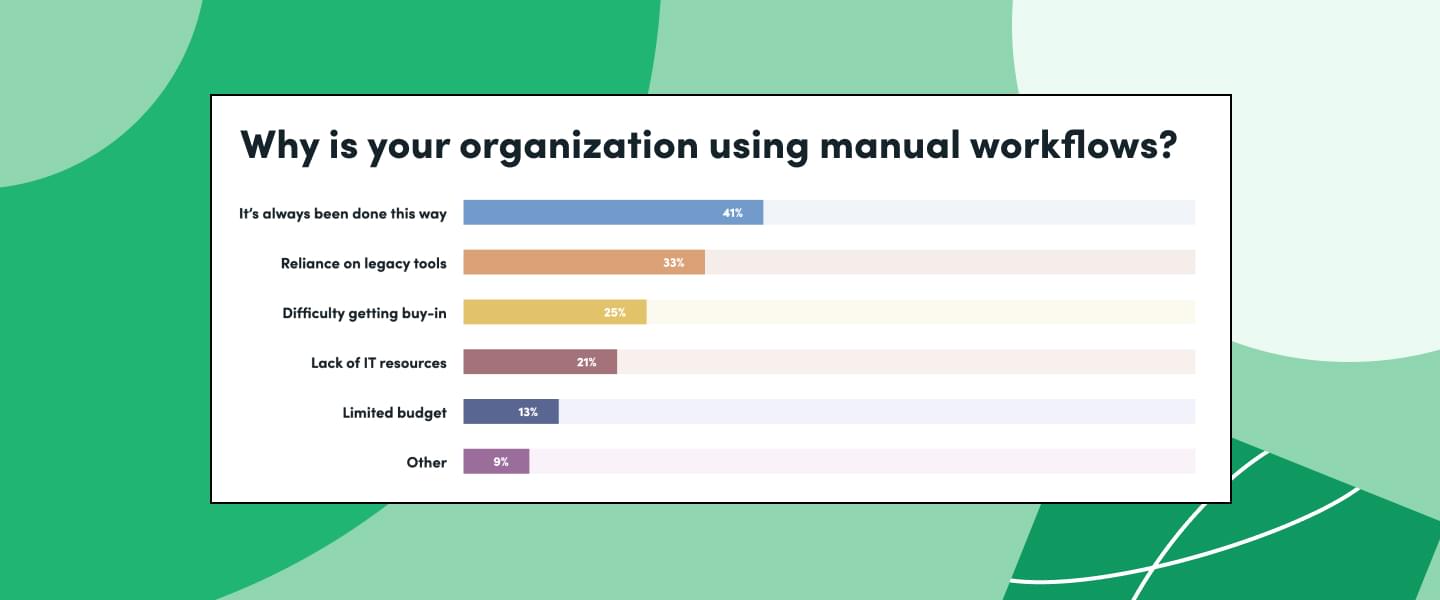Take a moment to imagine a company that is highly efficient—one that has streamlined all internal and external processes.
Employees are no longer bogged down with manual, repetitive tasks. They’re able to spend more time working on projects that deliver significant impact and improve the customer experience. Thanks to this level of efficiency, the company can quickly scale or adapt to address changing customer needs and market shifts.
If this ideal is what your organization is striving for, I have good news for you—it’s completely achievable. But it will take some strategic steps to get to this state of efficiency.
Our 2022 State of Digital Maturity report found that only 4% of organizations have reached this level of optimal digital maturity. This means a majority of organizations still run on inefficient processes. In fact, 51% of workers report spending at least two hours per day on repetitive tasks. Why? Because they continue to do things the way they’ve always been done and struggle to optimize business processes.
Legacy technology is a primary culprit behind this lack of efficiency. One in three organizations reports that a reliance on legacy technology limits their ability to improve their workflows. This points to technology that can't easily adapt and change to address business needs.

It’s clear that many organizations still rely on legacy technology to run their business. Yet the negative impacts of this choice can no longer be ignored. Mia Jordan, a Digital Transformation Executive at Salesforce, recently joined us on an episode of Formstack’s Practically Genius podcast to discuss the issues caused by legacy technology. You might be surprised by how many areas of business these tools can impact.

Listen Now: Get Mia’s best advice on how to modernize legacy systems by listening to her episode Saying Goodbye to Legacy Technology for Good now.
What Is Legacy Technology?
Before we get too far into explaining the issues that stem from using legacy technology, we should define the term. So what exactly is legacy technology?
In short, legacy technology or legacy systems are outdated pieces of technology that do not have the capabilities of modern tools. If you look up the word legacy as an adjective, Merriam-Webster describes it as “of, relating to, or being a previous or outdated computer system” and “of, relating to, associated with, or carried over from an earlier time, technology, business, etc.”
There’s not a set amount of time that makes a piece of technology legacy; it all depends on the speed at which that type of software or tech is updated. For instance, an iPhone 6 could be considered legacy technology even though it is less than a decade old.
Here are some reasons a system, software, or piece of technology may be considered legacy:
- The creators don’t maintain, support, or update it
- The system requires heavy coding or technical knowledge to update
- Modern features are not included in the software
- The system does not integrate easily (or at all) with other tools
- It requires extensive amounts of maintenance to keep running
- The tool has many unaddressed cybersecurity vulnerabilities
- It lacks functionalities that are now expected for that type of tech
Mia pointed out that changing regulations, especially within the government sector, can also make some tools and systems legacy. “There's legislation—like broadband, like the Inflation Reduction Act, and all the things around energy that are going to require new innovation and new systems.”
What Problems Are Caused by Legacy Technology?
“I’ve seen the internal chaos a legacy system can cause,” Mia said. “Over time, the system grows more and more inflexible, making it very difficult to deliver services efficiently and effectively.”
If your organization has been holding onto a piece of legacy technology, here are some of the issues it may be causing.
Failure to Meet Customer Expectations
Customer expectations have never developed as rapidly as they have over the last three years. “COVID pushed us from a technology perspective; there hasn't ever been a rollout of technology on such a massive scale before,” Mia explained.
This rollout of new technology transformed the way people do everything, from ordering groceries to seeing their doctor. “We set a new standard for customers to be able to engage digitally, and falling back into the status quo of what it was like prior to COVID is completely unacceptable,” Mia said.
Organizations that still rely on legacy technology for customer interactions will soon be unable to compete with their more modern counterparts. Customers now expect to be served digitally and rapidly, and many legacy technologies cannot keep up with these expectations.
Legacy technology can frustrate customers because it may:
- Slow down processes
- Include unnecessary steps in a workflow
- Require downloading software
- Have a clunky or complicated interface
- Depend on manual steps, like printing paperwork
- Be confusing to use

Pro Tip: How do leaders at more digitally mature organizations know modernization efforts are creating better customer outcomes? They focus on improving and evaluating the customer experience. Thanks to this data, they can identify how technology impacts customer experience and satisfaction.
Poor Employee Experiences
The customer experience is essential to business success, but so is the employee experience. If your employees are burdened by the technology in their tech stack, it may be time to reevaluate. Mia explained:
Legacy tech creates poor employee experiences because the tools are usually very technical. They can be cumbersome and complicated to use, and nontechnical employees may not be able to manage these systems if they break or need adjusting. Usually, someone from IT or a developer will have to get involved if any changes are needed.
This reliance on technical employees causes significant delays and internal disruptions. Our research found that the more legacy technology there is in your tech stack, the more likely you are to have projects delayed. This produces poor employee morale and may lead employees to seek out organizations that invest in more modern and user-friendly technologies.
“The technology you choose has to be flexible enough that if we get down the road and a decision is made that we actually don't want to do it that way, the system is flexible enough that you can go in and implement a change,” Mia stated. Most legacy technology does not offer this type of flexibility, which limits an employee’s ability to make any type of change.
Related: Is Customer Experience Rooted in Employee Experience?
Security Vulnerabilities
Mia sees security vulnerabilities as one of the biggest issues with legacy technology. She explained, “Because technology has changed and cybersecurity has become front and center, there are systems that—quite frankly—don't have the security measures in place to continue to be used.”
When older systems are not frequently updated or maintained, they are left with security gaps that hackers can easily exploit. This is especially true for systems that have been heavily patched to make up for system limitations.
The security risk is further magnified by the fact that making any fixes or updates likely requires IT or a worker with technical expertise. If a security breach happens, you may not have quick access to the employees needed to fix the issue. And even if you do, it may take time for them to fix it, which further exacerbates the issue.
If you’re in a highly regulated field, like healthcare or government, you may also be risking staying within compliance requirements. Tools that were built years (or decades) ago will not have the structures in place to comply with newer regulations. If a tool you’re using is behind in making the necessary changes to stay compliant, you’re better off looking for a more modern alternative.

Inefficient Workflows
One major issue with legacy software is that it frequently lacks the native integrations of more modern systems. Because of this, it can be difficult to integrate with current or future tools. The heavy lifting required to successfully integrate the system may deter your team from doing it, which will lead to data silos and an immense amount of manual data entry.
This inability to integrate with other tools will impact your organization’s flexibility and scalability. If you’re heavily reliant on the piece of legacy tech, you may avoid expanding your tech stack for fear that new tools won’t work with your existing software. This will limit your ability to innovate, experiment, and grow over time.
Keeping software in your tech stack that is unable to integrate with other tools can also impact your workflows across departments. If other departments begin modernizing their tech stacks, maintaining cross-departmental workflows will become more difficult. Over time, data will become more fragmented, and inefficient workflows will suck up more time and resources.
Tips for Replacing Legacy Technology
If you’re convinced it’s time to ditch the legacy technology in your tech stack, you may be wondering how to get started. It won’t be a quick or easy process, but these steps can help you navigate the digital transformation.
Create a working group. Replacing legacy technology can be a fairly heavy lift. To ensure this big of a project goes well, build a working group that includes a variety of departments and roles to help identify the right solution. All departments that use the system should be represented in the working group. IT and finance should also be involved to avoid hitting major roadblocks later on.
Do a tech stack audit. Before you investigate options for replacing your current legacy system, it’s important to know what tools are in your tech stack. Build a list of the tools used not only in your department but in the organization as a whole. You may find a tool within your organization that has the functionality needed to replace your current system.
Look for a platform solution. If you’re replacing multiple pieces of legacy tech at once, investing in a platform can be incredibly helpful. You’ll only need to go through onboarding once, plus a platform can be easier to maintain and grow over time. If there’s a platform within your organization’s tech stack that could be used as the replacement, start there. Mia explained why:
It is likely to take quite some time to navigate the transition from a legacy tool to something more modern, but it will be well worth the effort. You’re likely to see multiple positive outcomes from the change, including better ROI, improved productivity, and happier customers and employees.
It’s Time to Modernize Legacy Technology
The first step to fixing a problem is accepting that you have one. So if you’ve gotten this far and are realizing legacy tech is causing problems within your organization, take a moment to acknowledge that you’re putting in the work to get to a solution. It may take time and effort to find the best solution for your organization, but it will only lead to positive outcomes in the end.
Learn more about how to modernize legacy technology by listening to Mia Jordan’s Practically Genius podcast episode Saying Goodbye to Legacy Technology for Good now.











